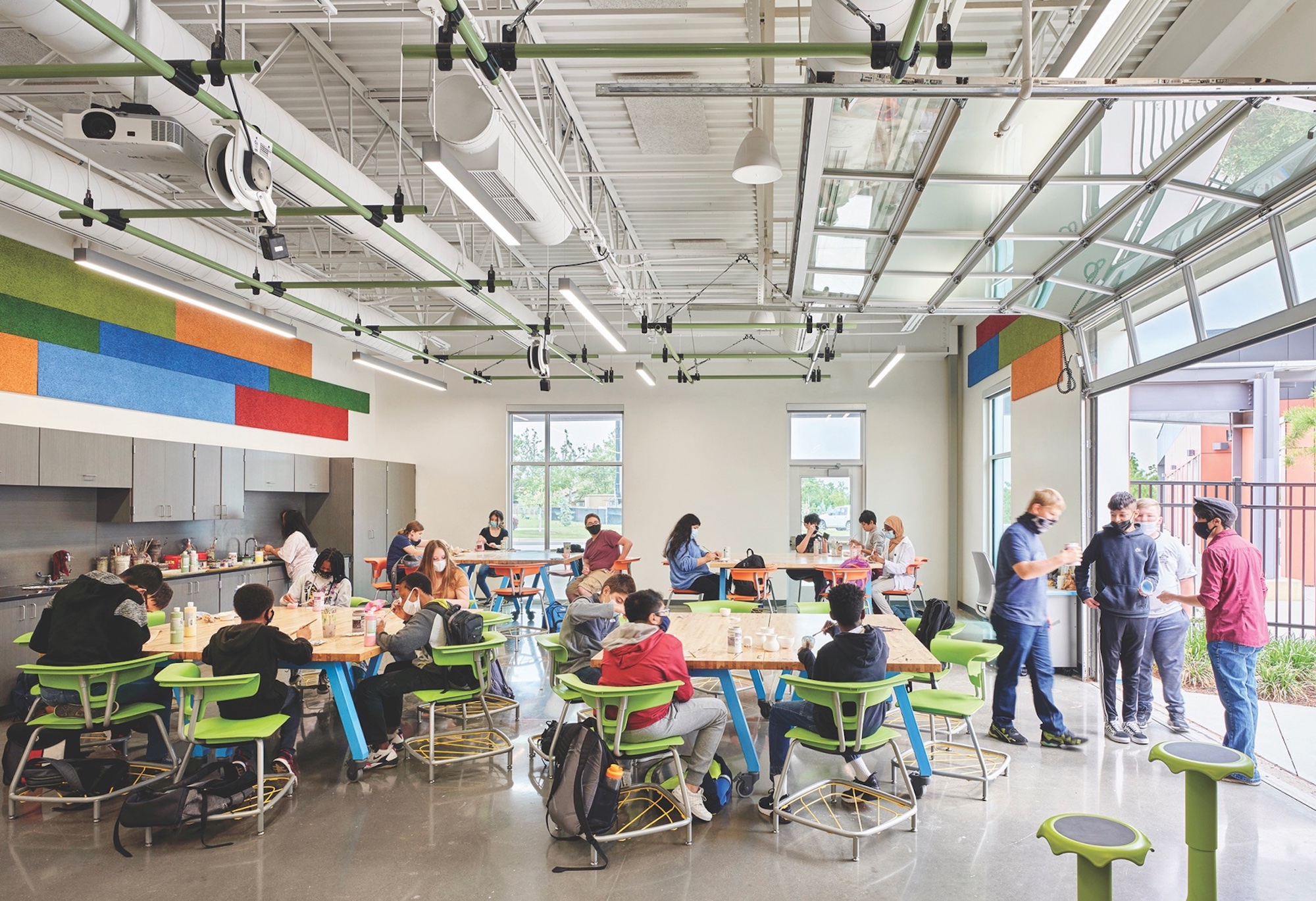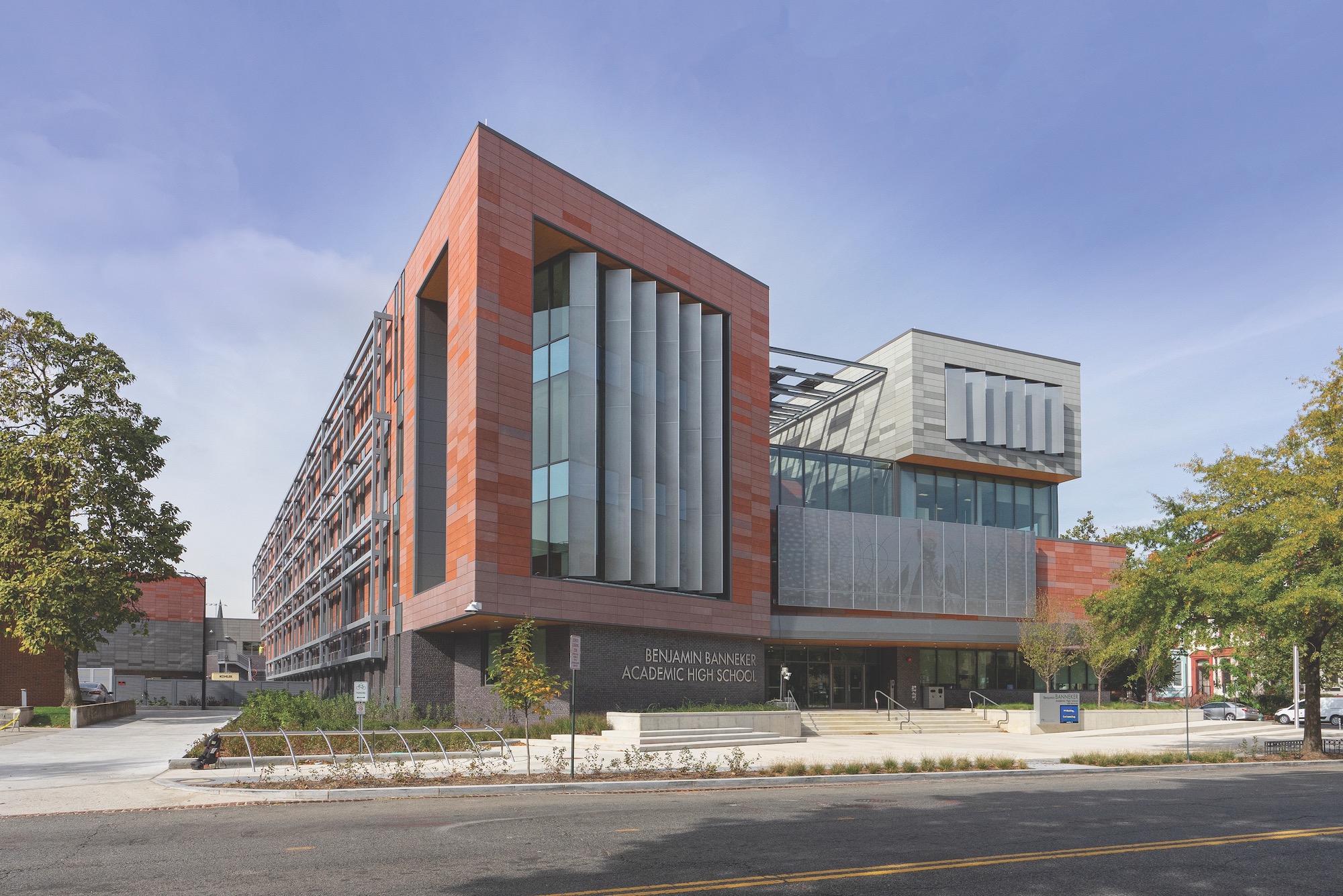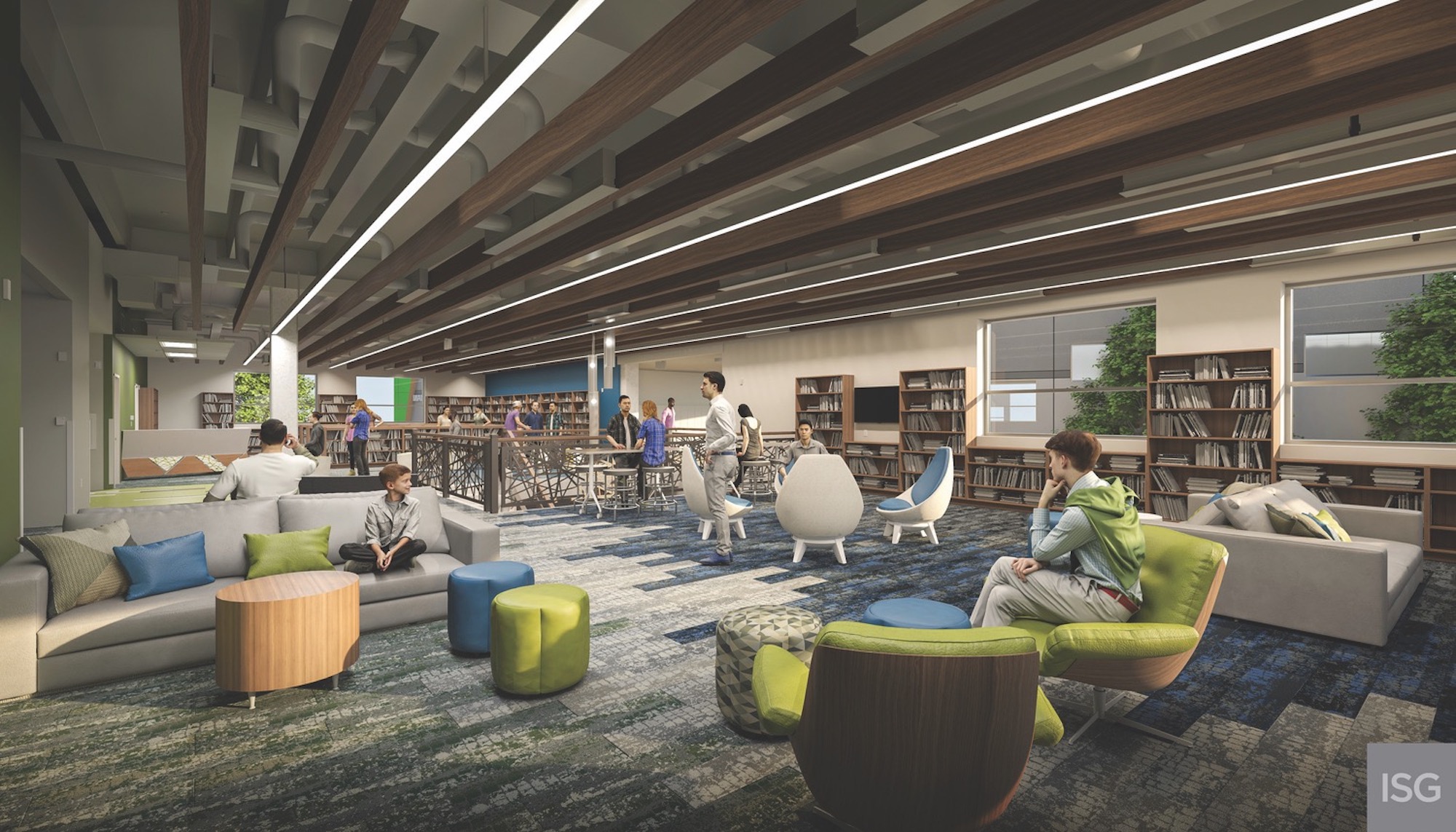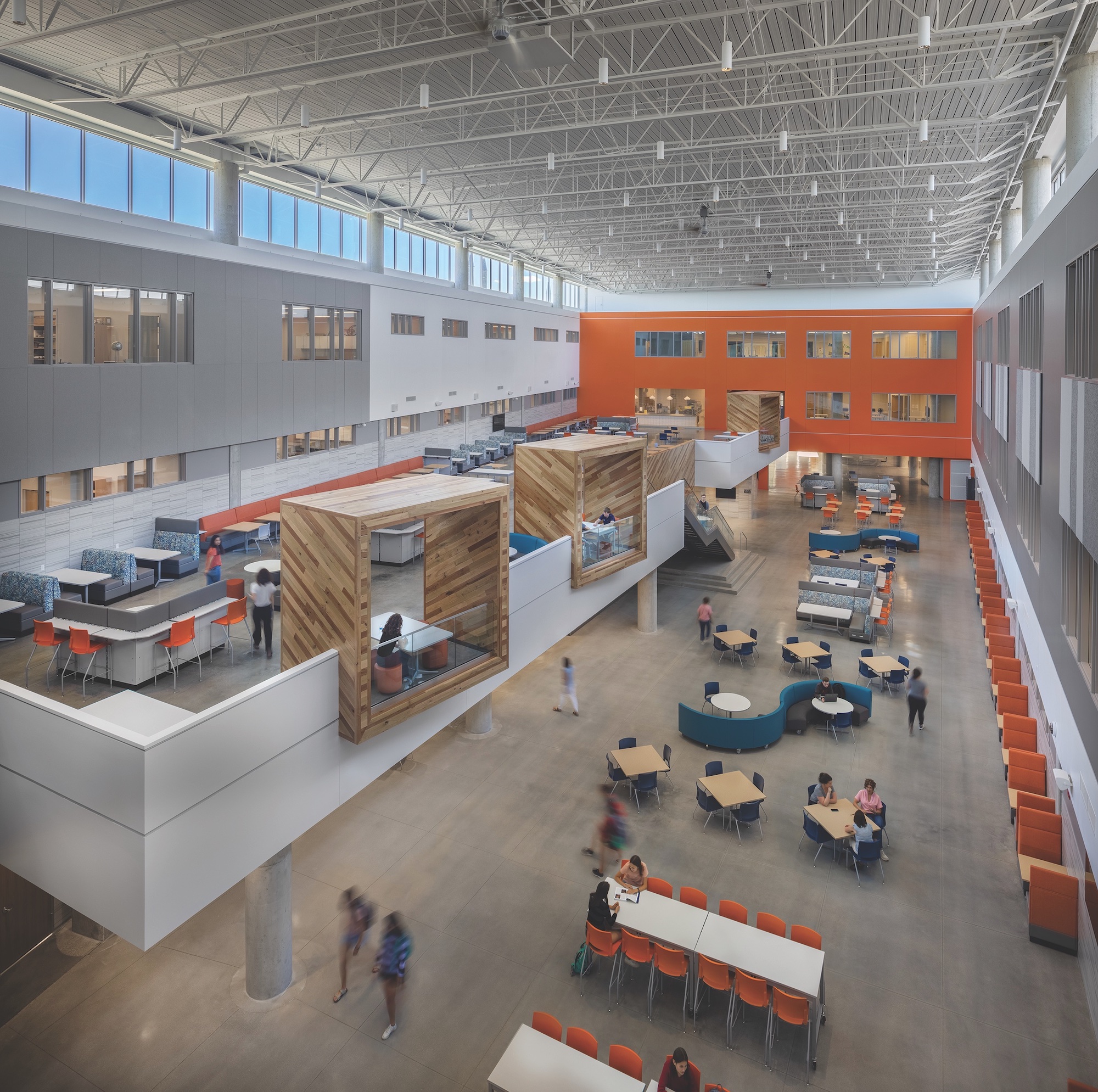During the past year, general contractor Findorff started work on more than $300 million in large-scale renovations for one of Wisconsin’s largest K-12 school districts. That work includes $70 million in each of the district’s four comprehensive high schools, significant improvements to a smaller community-based high school, and the construction of a new elementary school to improve structure equity in the district.
The global design firm DLR Group has been seeing more community and school-district interest in adaptive reuse, specifically in transforming vacant retail, warehouse, and other large-volume spaces into educational environments, according to K-12 Education Design Leader Todd Ferking, AIA.
While new construction comprises a sizable portion of AEC firms’ K-12 work, renovations and adaptive reuse are often the preferred modernization options for school districts and municipalities. “The majority of our K-12 work is still very renovation heavy. Much of the K-12 infrastructure isn’t feasible to replace, nor is replacement always necessary,” says Vaughn Dierks, AIA, LEED AP, Partner in Charge at Wold Architects + Engineers. One of his firm’s recent design examples is White Bear Lake (Minn.) High School, a reuse of the original core buildings with major interior reconfigurations, new additions, and systems replacements.
The choice between renovation or new construction often comes down to land, agree Skanska executives in five markets—Seattle, Portland, Ore., Tampa, Boston, and Cincinnati—who responded to BD+C’s questions. New construction makes up the majority of Skanska’s K-12 projects in the Pacific Northwest, Massachusetts, and Ohio, whereas renovations are more common in Florida. “No matter what the region, for school districts with available land, we see more new construction, while those without land are relying on renovations, adaptive reuse, or demolishing and replacing facilities,” the firm states.
However, as Christin Misna, Findorff’s Director of Education Market, notes, new construction still makes sense when schools consolidate in reaction to enrollment declines, or when a building has reached the end of its lifespan, or if the costs of repairs or renovations exceed the benefits of building new.
Balancing security and wellness in K-12 schools
Regardless of whether the project is new or a rehab, school districts prioritize safety and security of students, faculty, and staff. In one of its large high school replacement projects, Skanska is demolishing an existing school, which is only 40 years old, because its campus was designed in an open California style with multiple entrances. “The new high school is designed to create a single entrance point for a controlled, safe campus,” explains Trevor Wyckoff, Skanska’s Vice President and Account Manager in Oregon.

“Safety is at the forefront for every design decision, scope option, logistical consideration, and program for a K-12 project,” assert Jason Santor and Travis Coombs, the construction firm CORE’s Director of Preconstruction in Arizona and Vice President in Nevada, respectively.
The safety measures that AEC firms say are being designed or built into K-12 schools include impact-resistant glass at interior and exterior glazed entrances that provide visibility to gathering spaces, secure vestibules that might also include video surveillance, landscape design that limits hiding places for perpetrators, lockdown zones with strategic door hardware schedules to hinder access to classrooms and shelter-in-place spaces, and “conceal spots” within the school where students can protect themselves.
That being said, AEC firms are designing schools, not jails, points out Wold’s Dierks. While many AEC firms and their clients continue to follow Crime Prevention Through Environmental Design (CPTED) principals, they’ve also made efforts to balance safety with wellness. “There is a major focus to incorporate principles such as natural surveillance, territorial reinforcement, natural access control, maintenance, lighting, and landscaping,” say three executives from the design firm Orcutt|Winslow who responded to BD+C’s questions.
DLR Group’s Ferking has observed a shift toward designing for social and emotional health, so that bullying and violent behavior can be stanched, and students in distress can be more easily identified.To those ends, technology plays an increasingly important operational role for K-12 schools. “Technology is no longer an option in schools; it’s a requirement,” says Susan Tully, Gilbane Building Company’s K-12 Education Leader. She’s seeing more demand for robust wireless infrastructure, and the installation of new communication systems into existing schools.
The proliferation of mobile interactive flatscreen monitors is giving schools the flexibility to use spaces like cafeterias and gyms as teaching stations, observes Tina Stanislaski, a Principal with Cambridge, Mass.-based HMFH Architects. What has surprised the executives at Orcutt|Winslow is that, after two years of COVID-induced remote learning, which some districts predicted would be transformative, teachers are once again leaning toward interpersonal and even analog learning methods. “People are starved for human connection, and there does not seem to be a digital replacement,” the firm’s execs say.
Technology upgrades are probably most evident in schools’ indoor air quality and acoustics. Arlington (Va.) Public Schools contracted the engineering and building performance consultant CTMA to provide an analysis of the district’s classrooms to ensure they met ASHRAE air quality and ventilation standards. The district spent $500,000 on upgrades, new filters, and equipment that included more than 2,000 Certified Air Cleaning Devices that CMTA installed, confirms Tony Hans, the firm’s Vice President.

Washoe County (Nev.) School District, which has been on a school building binge over the past six years, realized that it needed to pay more attention to acoustical performance throughout all spaces, and particularly in music rooms and multipurpose rooms, say CORE’s executives, whose firm has worked with the district on a number of school projects.
Acoustical issues “are often overlooked” in school design, says Mark Quattrocchi, FAIA, Principal at Quattrocchi Kwok Architects, and such oversights can be detrimental to comprehension, communications, and student wellbeing. QKA typically retains a consulting acoustical engineer to advise on its K-12 construction and renovation projects.
Skanska’s Highline High School project, which is near Seattle’s Sea-Tac International Airport, received an FAA grant to cover the cost of acoustic elements to dampen aircraft noise. Skanska worked with an acoustical consultant to determine potential solutions, which resulted in value engineering the roof of the school’s 400-seat theater that was constructed using a perforated cellular acoustical deck and multiple layers of drywall.
Exposing K-12 school students to the outdoors
When HMFH installs HVAC systems into schools, it typically favors displacement ventilation in lieu of air conditioning. Displacement ventilation supplies 100% outdoor air that never recirculates, says Stanislaski, who adds that there’s less upfront cost because the system has fewer moving parts that require maintenance.
This choice accentuates how school projects are creating more access to the outdoors for social distancing, comfort, cognitive alertness, and as a learning tool. “We are starting to see this,” says Shane Butler, Kraus Anderson’s Construction Executive and Senior Project Manager. Two of his firm’s recent construction management projects—the preK-12 Red Rock Central and North Park School for Innovation, both in Minnesota—will feature outdoor classrooms.
SEE ALSO:
• Top 160 K-12 School Sector Architecture and AE Firms for 2022
• Top 70 K-12 School Sector Engineering and EA Firms for 2022
• Top 100 K-12 School Sector Contractors and CM Firms for 2022
CORE has seen multiple districts creatively integrate the outdoors into their schools via roll-up doors, courtyard spaces, and exterior amphitheaters. Its executives point specifically to the Eagle Valley Middle School addition being constructed for the Carson City (Nev.) School District, which incorporates an architectural masonry wall that serves as a projection screen, an exterior learning stair, and a garden.
“We typically work with our landscape architects to design various outdoor educational spaces” that include hands-on gardens, wetlands labs to study plants and animals, and green roofs for outdoor science labs and health classes, says HMFH’s Stanislaski. “These connections need not complicate design or construction, but do expand learning spaces at minimal cost to the project budget.”
Proposed and existing mandates drive sustainability in school construction
HMFH is among the AEC firms that districts are asking to make their schools more sustainable by reducing their energy, water, and waste. Districts are trying to stay ahead of municipal, state, and federal mandates that are calling for net-zero energy in new construction. Districts are also reframing sustainability as more than a checklist of requirements for resource conservation to where the discussion revolves around the wellbeing and needs of students and the community, say DLR Group’s Ferking and Gilbane’s Tully.

One of HMFH’s projects, the Annie E. Fales Elementary School in Westborough, Mass., is the first net-positive energy public school in New England. Another project, Bristol County Agricultural High School, is the first Massachusetts public school to use composting toilets, which helped cut the school’s water use in half even as enrollment increased by 40%. And a third, Arlington High School, is one of Massachusetts’ largest all-electric carbon-free public high schools.
CTMA has designed 36 net-zero energy K-12 schools across the U.S. Hans says that as early into a school’s planning stage as possible, his firm sets sustainability goals for the project that include energy reduction, occupant health and wellness, and building certification targets. “This immersive process allows the team to look beyond standard systems and create a holistic picture of the whole building concept before the design is developed, ensuring the sustainable features are incorporated and maintained during construction,” says Hans.
Skanska recently completed an energy management program for Hillsborough Public Schools in Florida. With more than 270 buildings, “the district’s energy bill is substantial,” says Daniel Abou-Jaoude, Vice President and Account Manager for Skanska’s Florida operations. The program included a district-wide, $100 million energy retrofit for LEDs and lighting controls that cut the district’s energy bill by 35-40%, which Abou-Jaoude says translates into $30 million in savings per year.
Related Stories
| Aug 11, 2010
Nursing home turned charter school opens in Dorchester, Mass.
Cambridge, Mass.-based HMFH Architects spearheaded the design for the conversion of a former nursing home in Dorchester, Mass., to learning and community space for the Neighborhood House Charter School. The pre-K—8 school has two classrooms for each elementary grade level, clusters of middle school classrooms, a cafeteria, media center, and art, computer, music and science classrooms.
| Aug 11, 2010
Modest recession for education construction
Construction spending for education expanded modestly but steadily through March, while at the same time growth for other institutional construction had stalled earlier in 2009. Education spending is now at or near the peak for this building cycle. The value of education starts is off 9% year-to-date compared to 2008.
| Aug 11, 2010
Las Vegas high school focuses on careers in justice, emergency response
McCarthy Building Cos., St. Louis, recently completed construction on the 130,700-sf Veterans Tribute Career & Technical Academy, a Las Vegas high school that focuses on service career pathways in 911 dispatch training, law enforcement, crime scene analysis, emergency medical training, and computer forensics.
| Aug 11, 2010
Three Schools checking into L.A.'s Ambassador Hotel site
Pasadena-based Gonzalez Goodale Architects is designing three new schools for Los Angeles Unified School District's Central Wilshire District. The $400 million campus, located on the site of the former Ambassador Hotel, will house a K-5 elementary school, a middle school, a high school, a shared recreation facility (including soccer field, 25-meter swimming pool, two gymnasiums), and a new publ...
| Aug 11, 2010
7 Keys to Unlocking Energy Efficiency in Schools
Today’s best K-12 schools are embracing the sustainability ethos in their design and construction, and that can mean a healthier, more comfortable indoor environment and improved learning. Some studies contend that ample amounts of daylighting, for example, lead to higher test scores. High-performance HVAC systems that constantly draw fresh air into a classroom seem to help both teachers ...
| Aug 11, 2010
Blue-Light Schoolhouses
Add the explosion in the number of school-aged kids nationally to the glut of huge, vacant stores in many communities and what do you get? Big boxes being turned into schools. For districts facing population pressure, these empty retail buildings can be the key to creating classrooms quickly, and at a significant cost advantage.
| Aug 11, 2010
Great Solutions: Green Building
27. Next-Generation Green Roofs Sprout up in New York New York is not particularly known for its green roofs, but two recent projects may put the Big Apple on the map. In spring 2010, the Lincoln Center for the Performing Arts will debut one of the nation's first fully walkable green roofs. Located across from the Juilliard School in Lincoln Center's North Plaza, Illumination Lawn will consist ...
| Aug 11, 2010
Dream Fields, Lone Star Style
How important are athletic programs to U.S. school districts? Here's one leading indicator: In 2005, the National Football League sold 17 million tickets. That same year, America's high schools sold an estimated 225 million tickets to football games, according to the American Football Coaches Association.
| Aug 11, 2010
Back to Nature: Can wood construction create healthier, more productive learning environments?
Can the use of wood in school construction create healthier, safer, more productive learning environments? In Japan, there's an ongoing effort by government officials to construct school buildings with wood materials and finishes—everything from floors and ceilings to furniture and structural elements—in the belief that wood environments have a positive impact on students.
| Aug 11, 2010
High School in a Hurry
One of the more compelling arguments for charter schools is their theoretical ability to streamline decision making. Eliminate all those layers of bureaucratic fat that clog the arteries of most public school systems, the argument goes, and decisions can be made to flow much more smoothly, even when it comes to designing and building a major school project.







